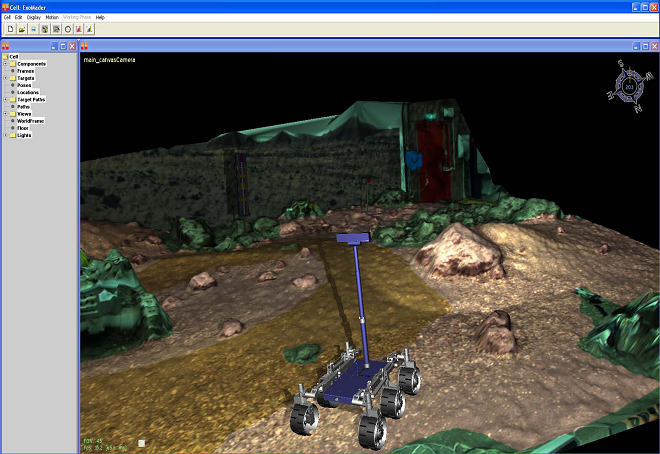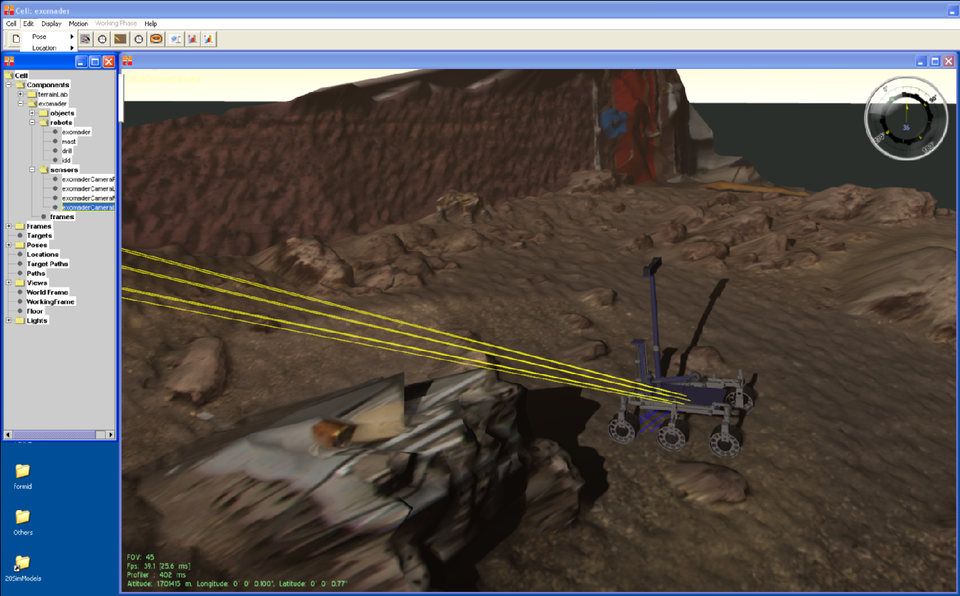New planetary simulation software puts ESA rover designs to the test
ESA's ExoMars mission to Mars is due to be put to the test using advanced planetary surface simulation software incorporating video-game quality 3D graphics, set to serve as an important design tool for future missions.
Robot rovers are becoming major elements of ESA's next-decade planetary exploration strategy. Both Moon and Mars rovers are being studied.
Up until now the main way of assessing rover designs has been simply to construct engineering models. But a newly-completed software tool known as the 3DROV planetary rover simulation environment allows early-stage virtual modelling and 'shakedown' testing of mobile surface missions for both Mars and the Moon.
Operation and environment-based system design

"A rover is a small spacecraft in its own right, its system design guided by operational and environmental factors," says Luc Joudrier of ESA's Robotics and Automation Section. "When it comes to designing standard orbital spacecraft we already more or less know the parameters of the space environment”.
"With rovers by contrast there is a high level of uncertainty about the terrain and conditions to be encountered. 3DROV makes such environmental information available early on in the system design process, setting up representative terrain, atmospheric conditions, temperature and illumination."
As well as introducing representative environmental components – down to the effects of wind-blown dust, 3DROV simulates how the rover design interacts with them, modelling its physical motion across the surface and the performance of its scientific instruments, solar panels and power, electrical and thermal subsystems, modelled right down to the required detail level.
3DROV also extends beyond the Martian surface to take account of orbital factors, calculating when the Sun is rising and times when the rover lines up either directly with Earth or else to a relay orbiter, making ground communications feasible.
Multiple simulations in one
3DROV employs an existing ESA spacecraft operation simulator called SIMSAT as its framework, within which other simulation models can be added. These include the Mars Climate Database, a collection of Martian weather data based on spacecraft observations and numerical modelling, and NASA's SPICE Toolkit which provides planetary orbit information.
Digital Elevation Models or survey images of planetary surfaces gathered from orbital probes can also be input using a geographic information system (GIS).
Automated systems given virtual rehearsal

Future rovers will operate too far from Earth for true remote control to be feasible. Instead the human operator defines a task but the rover itself decides how to execute it. To assess how rover automation might work in practice, 3DROV incorporates a generic robotic controller evolved out of ESA's previously developed MUROCO (Multi RObot behaviour CO-ordination) system..
"Another specialised element is the visualisation tool, which is based on an open source 3D rendering engine called OGRE," adds Mr Joudrier. "The boom in computer graphics driven by gaming and related applications has thrown up some very useful capabilities for us.”
"Good, fast graphics visualisation is important not just for a nice-looking simulation but also because robotics tend to have vision-based control systems. So the rover's view is input into the navigation algorithm which decides its path ahead, and if the graphics aren't sufficiently advanced then artefacts might be thrown up that make the algorithm work differently."
The behaviour of soil under rover wheels is manually defined by mapping 'terramechanical' characteristics onto surface areas. Subsurface properties can also be defined, a useful feature for simulating ExoMars activities, which is equipped with ground-penetrating radar and a subsurface drill.
Implementing the ExoMars rover

"We are currently working to implement the ExoMars rover model within the simulation," Mr Joudrier explains. "3DROV began as an independent R&D activity during which time the ExoMars model was not available. However we think testing the tool with real space designs should help measure its usability as well as proving useful for the ExoMars industrial team ."
The Robotics and Automation section also intends to operate 3DROV on a closed-loop basis. Commands will be exchanged between a rover simulation and a real-world engineering model in ESA's Planetary Utilisation Testbed - a rover-friendly 70 square metre sandpit located in ESA's ESTEC engineering centre in Noordwijk in the Netherlands. The aim is to see to how and why the modelled performance diverges from actual 'ground truth'.
3DROV: tool for future exploration
3DROV was initiated by ESA's Automation and Robotics Section through ESA's General Support Technology Programme. The Belgian company Trasys Space was the prime industrial contractor.
Both SIMSAT and 3DROV have been designed to be compliant with the Simulation Model Portability 2 (SMP2) standard, which enables the sharing of simulation models across different systems. A leading user of space simulations, ESA led the development of SMP2 through the European Committee for Space Standardization (ECSS).
ESA regards 3DROV and related simulations as important tools for the optimising and testing of future robotic missions, especially in the context of ESA and NASA's recently-announced Mars Exploration Joint Initiative and potential lunar exploration activities.
More information
Contact Luc.Joudrier @ esa.int















 Germany
Germany
 Austria
Austria
 Belgium
Belgium
 Denmark
Denmark
 Spain
Spain
 Estonia
Estonia
 Finland
Finland
 France
France
 Greece
Greece
 Hungary
Hungary
 Ireland
Ireland
 Italy
Italy
 Luxembourg
Luxembourg
 Norway
Norway
 The Netherlands
The Netherlands
 Poland
Poland
 Portugal
Portugal
 Czechia
Czechia
 Romania
Romania
 United Kingdom
United Kingdom
 Slovenia
Slovenia
 Sweden
Sweden
 Switzerland
Switzerland





























